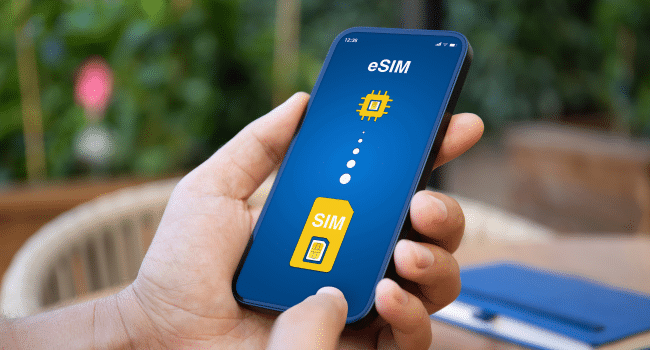Table of Contents
The concept of eSIM technology has been transforming the telecommunications landscape globally, and its impact in Australia is notably shaping the future of mobile connectivity. An eSIM, or embedded SIM, is a virtual SIM card that is built into a device and can be activated with mobile services without the need to use a physical SIM card. This technology has been gradually introduced into the Australian market and is poised to offer a plethora of benefits to consumers and network operators alike.
The Evolution of SIM Technology
Before delving into the specifics of eSIM technology’s prevalence in Australia, it is worth understanding how SIM cards have evolved over the years. The traditional SIM card has undergone several changes, scaling down in size from the standard SIM to the Micro SIM, and then further to the Nano SIM. However, eSIMs represent a more significant leap in this evolution, as they are not just a change in size, but a paradigm shift in how SIM cards are used and managed.
The Advantages of eSIM Technology
eSIM technology offers several advantages over traditional SIM cards. Firstly, it simplifies the process of switching between mobile network operators. Consumers no longer need to purchase and physically replace SIM cards; instead, they can switch providers or plans through software settings. Additionally, eSIMs support multiple profiles, allowing users to maintain several numbers and data plans on a single device. They also eliminate the need for physical SIM cards, making devices more resilient to wear and tear and potentially creating space for other features or hardware improvements.
Current State of eSIM in Australia
While the adoption of esim in Australia is in its nascent stages, it has been receiving a positive response from both network operators and device manufacturers. Australians are witnessing an increasing number of eSIM-compatible devices being introduced into the market, including the latest smartphones, smartwatches, and tablets.
Network operators in Australia are gearing up for this technological shift by updating their systems to support eSIM activation and management. Although the initial rollout has begun with premium devices and plans, it is expected that the availability of eSIM will eventually extend to a broader range of devices and services.
Benefits for Travelers and Business Users
eSIM technology is particularly beneficial for travellers and business users who frequently move between countries or require multiple numbers for professional and personal use. With eSIM, traveling abroad becomes hassle-free as users can subscribe to local data plans without the need to purchase local SIM cards. This also allows for more cost-effective international roaming options and the convenience of having home and local carrier profiles active simultaneously.
Environmental Impact
Beyond consumer convenience, there is also an environmental benefit to the adoption of eSIMs. The reduction in plastic waste associated with physical SIM cards is a small but meaningful step towards more sustainable technology practices. By eliminating the need for physical SIMs, eSIM technology reduces the environmental impact of producing, distributing, and disposing of millions of SIM cards each year.
Challenges Facing eSIM Adoption
Despite the clear benefits, the widespread adoption of eSIM technology in Australia does face some challenges. One such challenge is consumer awareness and education. Many customers are still accustomed to the traditional SIM card model and might be unaware of or hesitant about moving to eSIM. Telecommunications providers and device manufacturers will need to invest in educating the market about the advantages and ease of use of eSIMs.
Another challenge is the readiness of the existing infrastructure. Mobile network operators need to ensure that their systems can handle eSIM activations and management on a large scale, which may require significant upgrades and investment.
The Role of Network Operators
Network operators have a pivotal role to play in the rollout of eSIM technology in Australia. They must ensure a seamless and secure transition for customers looking to adopt eSIMs. This involves creating straightforward processes for activation, delivering robust customer support, and ensuring a secure platform for managing eSIM profiles.
Consumer Choice and Flexibility
eSIM technology empowers consumers with more choice and flexibility when it comes to selecting mobile network operators and plans. Gone are the days of being tethered to a single network due to the inconvenience of switching SIM cards. Now, consumers can manage their mobile services with just a few taps on their device.
The Road Ahead for eSIM in Australia
As the technology matures and becomes more prevalent, eSIMs are set to redefine the standards of mobile connectivity in Australia. Consumer demand, coupled with the advantages of eSIM technology, has the power to accelerate its adoption across the country.
The future of mobile connectivity with eSIM in Australia looks bright, offering a digital and innovative solution for the demands of modern telecommunications. It facilitates not just a change in user experience but also a foundational shift in the way mobile services are delivered and managed. Australians can expect a transition to more convenient, sustainable, and advanced mobile solutions as eSIM technology continues to evolve and proliferate.
In conclusion, the adoption of eSIM technology in Australia signifies a critical step forward in the realm of mobile connectivity. It offers a range of benefits that align with the trends of digitalisation, from a more flexible user experience to enhanced device functionality and a positive environmental impact. The transition to eSIM is paving the way for a seamless, integrated mobile future, and Australia is well-positioned to embrace these advancements and lead by example in the global telecommunications arena.
